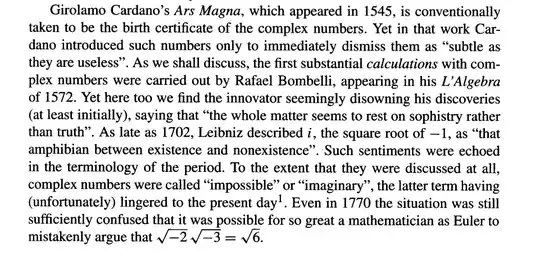Euler did write this, but it was not a mistake! Euler's statement was correct under his own definition of the notation that he was using.
I looked at the PDF version of Elements of Algebra linked to in SCappella's answer.
Reading Section I, Chapter XIII, I found that Euler wrote that most numbers have two square roots, which matches the definition of the phrase "square root" used by today's mathematicians[1]. He also wrote that the square root sign √ denotes both square roots, which does not match the definition of √ used by today's mathematicians[2], but which is not actually incorrect.
Here's what he wrote:
- We have before observed, that the square root of
any number has always two values, one positive and the
other negative; that √4, for example, is both +2 and
-2, and that, in general, we may take -√a as well as
+√a for the square root of a. This remark applies also
to imaginary numbers; the square root of -a is both
+√-a and -√-a; but we must not confound the
signs + and -, which are before the radical sign √, with
the sign which comes after it.
(Actually, the above does contain an error. Euler claims that every number has two square roots; in fact, every number has two square roots except for 0, which only has one square root, which is 0. Source at [3].)
Negative numbers have two square roots, one of which has positive imaginary component and the other of which has negative imaginary component. Nowadays, mathematicians use √ to mean only one or the other according to some rule[2], but we can see that to Euler, it would have meant either square root.
In particular, Euler considered √6 to mean either the positive or the negative square root of 6.
So, in Euler's notation, the equation (√-2)(√-3) = √6 meant "either square root of -2 times either square root of -3 is a square root of 6", which is completely true[4].
Some of today's mathematicians would interpret (√-2)(√-3) = √6 as being meaningless, because they decline to give the expression √-2 and the expression √-3 any definition at all[5].
I think other mathematicians would interpret it as meaning "the square root of -2 with positive imaginary component (i√2), times the square root of -3 with positive imaginary component (i√3), is the positive square root of 6", which is a false statement[6]—but which is also a misreading of what Euler wrote.
References and proofs:
- [1]: Weisstein, Eric W. "Square Root." From MathWorld--A Wolfram Web Resource. "A square root of x is a number r such that r^2=x."
- [2]: Ibid. "The principal square root of a [complex] number z is denoted √z [...]." The source does not include a definition of "the principal square root", but does make it clear that it is a function, meaning that it has only one value.
- [3]: Ibid. "Any nonzero complex number z also has two square roots."
- [4]: Proof: Suppose that x is a square root of -2 and y is a square root of -3. Then, by the definition of a square root, x2 = -2 and y2 = -3. As a consequence, (xy)2 = x2 y2 = (-2) (-3) = 6. This means, by the definition of a square root, that xy is a square root of 6.
- [5]: Denis Nardin's comment on this answer: "[I]n all my (admittedly short) career as a mathematician I never encountered a definition of $\sqrt{-2}$: in general it is considered an ill posed symbol (sort of like $0/0$, if you want)."
- [6]: I wasn't able to find a source for the definition of the principal square root of a negative number. However, it would be extraordinarily strange to define √-2 and √-3 as anything besides i√2 and i√3, respectively. (The only alternative would be to define √-2 as -i√2 or to define √-3 as -i√3, which would be inconsistent with the definition of √-1 as i rather than -i.) We have, thus, (√-2)(√-3) = (i√2)(i√3) = i2(√2)(√3) = -(√2)(√3) = -√6, which is negative, whereas √6 is positive.
